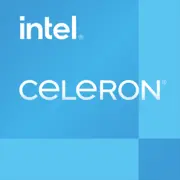Intel Celeron G6900T

Intel Celeron G6900T: Processo economico per compiti di base nel 2025
Panoramica delle caratteristiche, consigli per l'assemblaggio e confronto con i concorrenti
Caratteristiche principali: Architettura e prestazioni
Il processore Intel Celeron G6900T, lanciato nel 2022, rimane una soluzione valida per PC economici grazie alla sua efficienza energetica e al supporto delle tecnologie moderne.
- Architettura Alder Lake: Prima generazione di Intel con design ibrido, ma nel Celeron sono presenti solo Performance-cores (P-cores). Qui ci sono due, senza supporto per l'Hyper-Threading (2 core / 2 thread).
- Processo tecnologico Intel 7 (10 nm Enhanced SuperFin): Consumo energetico efficiente e ridotto output termico.
- Frequenza e cache: Frequenza di base – 2.80 GHz (senza Turbo Boost), cache L3 – 4 MB.
- Grafica integrata: Intel UHD Graphics 710 con 16 unità di esecuzione e supporto per 4K@60 Hz tramite HDMI/DisplayPort.
- Prestazioni: Nel test Geekbench 6 (2025) – 1400 (monotasking), 2457 (multitasking). A titolo di confronto, il Pentium Gold G7400 ottiene ~1600/3000, ma costa di più (~$75).
Punti chiave:
- Supporto per PCIe 5.0 (fino a 16 linee) – rilevante per futuri aggiornamenti.
- Compatibilità con DDR4 e DDR5 (dipende dalla scheda madre).
- Tecnologie Intel Quick Sync Video per la decodifica video.
Schede madri compatibili: Socket e chipset
Il Celeron G6900T utilizza il socket LGA 1700, consentendo di installarlo su schede madri con chipset H610, B660, H670 e Z690.
- H610: Opzione economica ($70–90). Esempi: ASUS Prime H610M-K, Gigabyte H610M S2H.
- Limitazioni: Nessun overclocking, 1 slot PCIe 4.0, 2 slot DDR4 (fino a 3200 MHz).
- B660: Scelta ottimale ($100–130). Esempio: MSI Pro B660M-A.
- Pro: Supporto per DDR4/DDR5 (a seconda del modello), più porte USB, 2 slot M.2.
Consiglio: Per il Celeron G6900T non ha senso acquistare schede con chipset H670/Z690: sarebbe eccessivo. Scegliete H610 o B660 con il tipo di memoria desiderato.
Memoria supportata: DDR4 vs DDR5
Il processore è compatibile con DDR4-3200 e DDR5-4800, ma il tipo di memoria dipende dalla scheda madre.
- DDR4: Nel 2025, un modulo da 8 GB costa ~$25. Adatto per compiti d'ufficio.
- DDR5: I prezzi sono scesi a $40 per 8 GB. Fornisce un aumento del 5–10% nelle prestazioni in giochi e applicazioni, ma per il Celeron non è critico.
Raccomandazione: Per un'assemblaggio basato su G6900T, è più vantaggioso usare DDR4 – la differenza di prestazioni non giustifica un sovrapprezzo.
Alimentatori: Calcolo della potenza
Con TDP di 35 W, il processore è estremamente poco esigente in termini di alimentazione.
- Senza scheda video dedicata: Basta un alimentatore da 300–400 W (ad esempio, be quiet! System Power 10 400W, $45).
- Con scheda video: Se prevedete di aggiungere una GPU di livello NVIDIA GTX 1650 (TDP 75 W), scegliete un alimentatore da 450–500 W (Corsair CX450, $55).
Importante: Anche considerando gli aggiornamenti, non è necessario pagare di più per alimentatori superiori a 500 W – il Celeron non eserciterà un carico elevato.
Vantaggi e svantaggi del Celeron G6900T
Vantaggi:
- Prezzo basso ($55–60 nel 2025).
- Efficienza energetica (ideale per assemblaggi compatti).
- Supporto per PCIe 5.0 e video 4K.
Svantaggi:
- Solo 2 core – multitasking limitato.
- Nessun Hyper-Threading – calo di prestazioni in applicazioni che utilizzano il multitasking.
- GPU integrata debole per i giochi: CS:GO – 40–50 FPS a impostazioni basse, GTA V – 25–30 FPS.
Scenari d'uso
1. Compiti d'ufficio: Lavorazione di documenti, browser (10+ schede), conferenze Zoom – il processore gestisce senza lag.
2. Media center domestico: Streaming video 4K, Netflix, YouTube – grazie a Intel Quick Sync.
3. Giochi leggeri: Minecraft, Dota 2, progetti indie – a impostazioni basse.
4. PC educativi: Adatto per notebook trasformabili per scuole/studente.
Limitazioni: Montaggio video, rendering 3D, streaming – richiedono CPU più potenti.
Confronto con i concorrenti
- AMD Athlon 3000G (Zen, 2 core/4 thread, $50): Inferiore in prestazioni monotasking (Geekbench 6 ~1100), ma superiore nel multitasking.
- Intel Pentium Gold G7400 (2 core/4 thread, $75): 20% più veloce nel multitasking, ma più costoso.
- Ryzen 3 5300G (4 core/8 thread, $100): La scelta migliore per i giochi, ma a un prezzo più alto.
Conclusione: Celeron G6900T è l'opzione più economica, ma solo per bisogni di base.
Consigli pratici per l'assemblaggio
1. Scheda madre: Gigabyte H610M S2H DDR4 ($75) + 8 GB DDR4-3200 ($25).
2. Memoria di archiviazione: SSD NVMe da 256 GB (Kingston NV2, $30).
3. Raffreddamento: Il dissipatore di serie è sufficiente – rumore minimo.
4. Case: Compatto Mini-ITX (Cooler Master Elite 110, $50).
Esempio di assemblaggio:
- Processore: $60
- Scheda madre: $75
- Memoria: $25
- SSD: $30
- Alimentatore: $45
- Case: $50
Totale: ~$285 (senza OS e monitor).
Conclusione finale: A chi si adatta il Celeron G6900T?
Questo processore è una scelta per chi:
- Compila un PC per ufficio, studio o navigazione.
- Vuole un mini-PC per media center (HTPC).
- Cerca una sostituzione economica per una CPU obsoleta senza aggiornare altri componenti.
Perché nel 2025 è ancora rilevante? Prezzo basso, compatibilità con nuovi chipset e DDR5, minimo consumo energetico. Tuttavia, per giochi o compiti complessi, è meglio aggiungere $20–30 e optare per Pentium Gold o Ryzen 3.
Se desiderate un sistema modernamente economico, il Celeron G6900T rimane un'opzione valida. Ma tenete a mente: le sue possibilità sono limitate, e un upgrade tra 2–3 anni è inevitabile.
Di base
Specifiche della CPU
Specifiche della memoria
Specifiche della GPU
Varie
Classifiche
Rispetto ad altre CPU
Condividi sui social media
Oppure linkaci
<a href="https://cputronic.com/it/cpu/intel-celeron-g6900t" target="_blank">Intel Celeron G6900T</a>